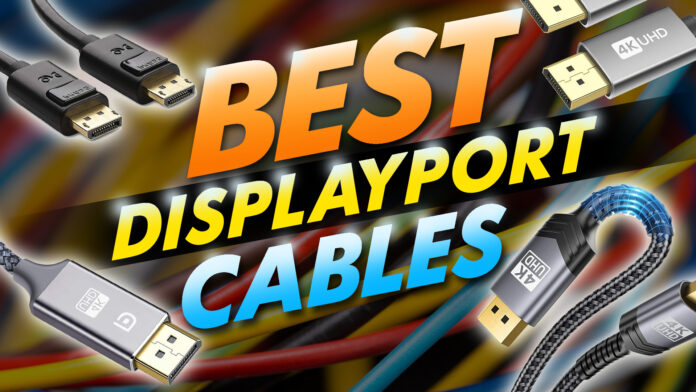

When setting your rig up, most of the important things to consider center around the hardware components for your devices. However, those devices need to connect somehow, and making sure that they connect properly to get the best results ensures you do not waste your or its resources.
| Preview | Product | Size | Price |
|---|---|---|---|
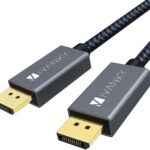 | iVANKY 4K DisplayPort to DisplayPort Cable | 3.3 ft , 6.6 ft, 10 ft, 15 ft | |
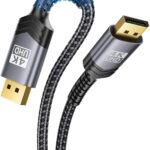 | JSAUX Gold-Plated Braided Ultra High Speed DisplayPort Cord | 3.3 ft, 6.6 ft, 10 ft, 15 ft | |
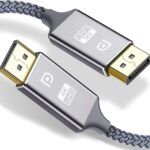 | Capshi DisplayPort Cable 4K DP Cable Nylon Braided | 3 ft, 6.6 ft, 10 ft, 15 ft | |
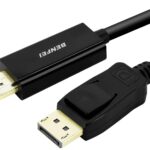 | Benfei Display Port to HDMI | 3 ft, 6 ft, 10 ft, 15 ft | |
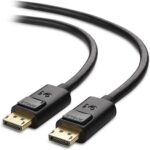 | Cable Matters DisplayPort to DisplayPort Cable 4K Resolution Ready | 3 ft, 6 ft, 10 ft, 15 ft, 25 ft | |
 | Silkland Braided Display Port Cable | 6.6 ft, 10 ft | |
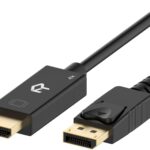 | Rankie DisplayPort (DP) to HDMI Cable, 4K Resolution Ready | 6 ft, 10 ft, 15 ft |
One of the more commonly overlooked parts of this arrangement is the cables as most people make sure they get the proper connections and do not think twice. Unfortunately, devices and hardware are not always optimized for one another which makes choosing the right cable vital– especially if you want to use a 4K TV or gaming monitor.
That is why we put together this list of the best DisplayPort cable options, highlighting what each one does best. We also provide a helpful buyer’s guide, so you can get the most out of your hardware and enjoy the benefits of a high-end setup without having to worry about technical headaches.
1. iVANKY 4K DisplayPort to DisplayPort Cable
Best All-Around DisplayPort Cable
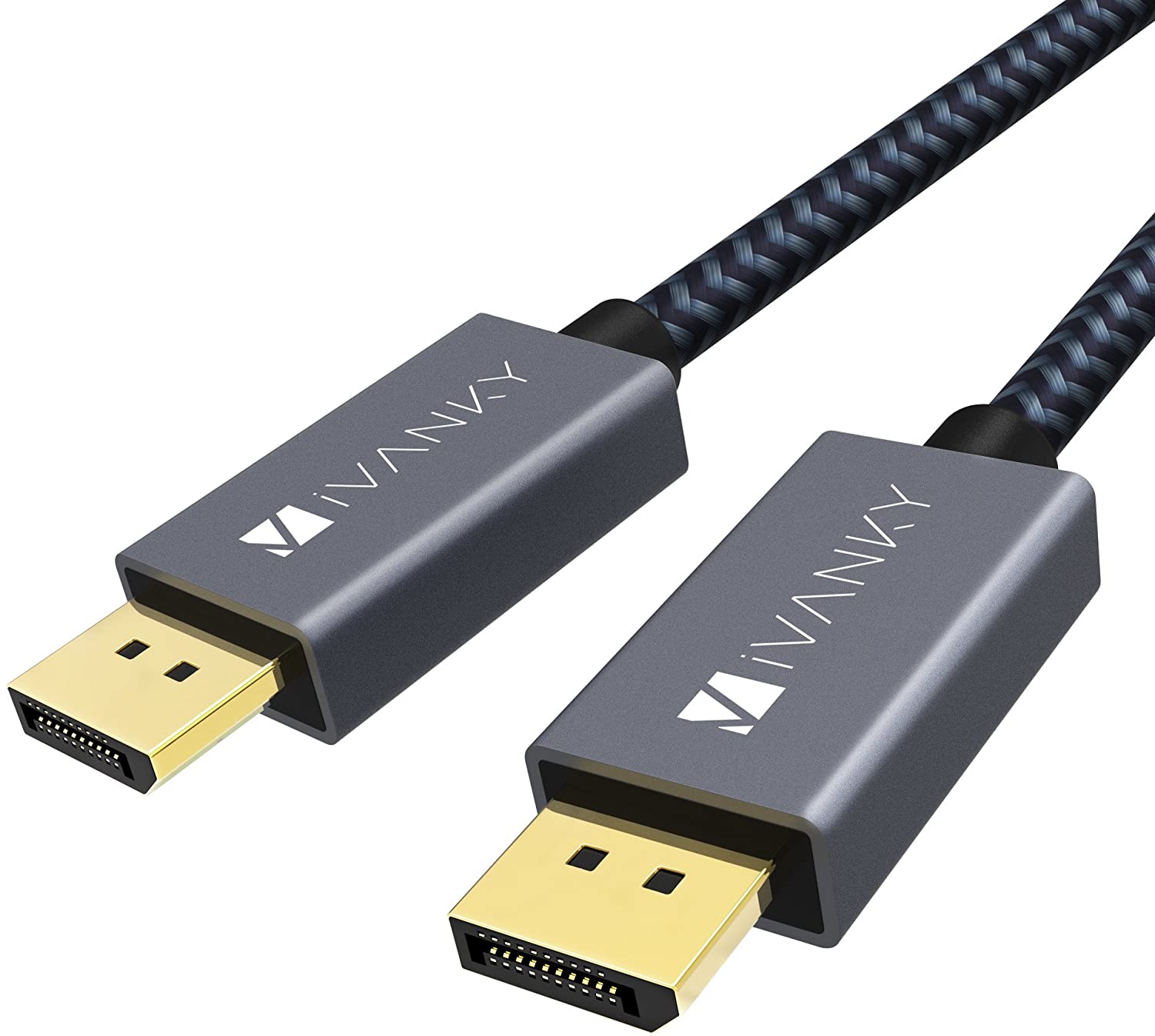
iVANKY is a relatively new company with less than half a decade of experience, but they specialize in audio and video cables to provide excellent connection solutions. The iVANKY DP to DP Displayport Cable is a great example of this as it boasts some excellent specs while avoiding the pitfalls of some of its competitors.
For starters, this DisplayPort cable is one of the few DP to DP models on our list that does not suffer from the durability issues often seen in non-VESA cables. That said, the iVANKY DP to DP Displayport Cable is not VESA-certified either which explains why it has some issues when trying to run higher refresh rates– regardless of what it advertises.
That said, this DisplayPort cable performs extremely well otherwise with a braided nylon sheath that boasts a 15000 bend lifespan. On top of that, the iVANKY DP to DP Displayport Cable also offers solid shielding thanks to its aluminum foil shield reinforced by an aluminum-magnesium wire mesh shield layered over top.
One thing to keep in mind is this DisplayPort cable may not be the best for VR gaming or regularly moved displays as the connectors do not lock. Thankfully, the connections are otherwise excellent with a durable aluminum alloy shell, integrated molding, and 24k gold-plated connectors.
Even better, this DisplayPort cable employs 28 AWG tinned copper wire, making sure that you do not have to worry about the wire degrading over time.
2. JSAUX Gold-Plated Braided Ultra High Speed DisplayPort Cord (4K@60Hz, 2K@165Hz, 2K@144Hz)
Best 3M DisplayPort Cable
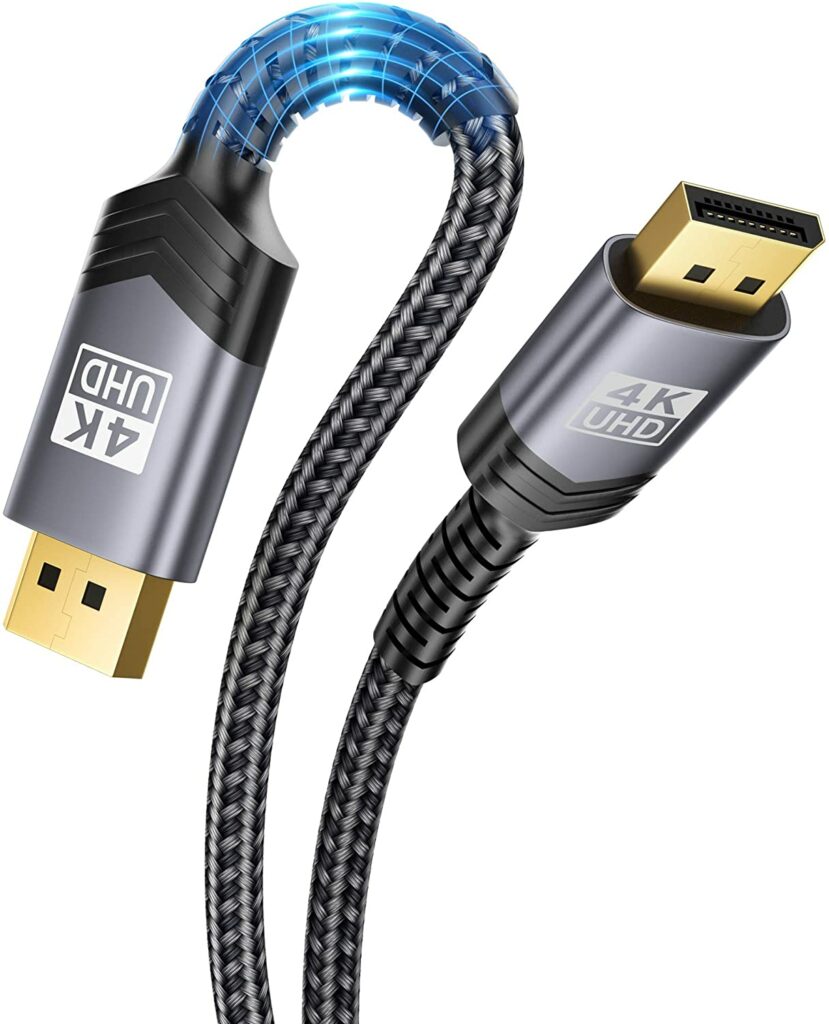
JSAUX is another company on our list that is fairly young, but they too focus primarily on audio and visual cables– though they also offer some accessories too. Regardless, the JSAUX DP to DP DisplayPort Cable sees some notable performance improvements compared to much of the competition.
For starters, this DisplayPort cable is easily the most durable entry we reviewed with a braided nylon sheath that boasts a 30000 bend lifespan– twice as long as the next closest competitor. On the other hand, this added durability reduces the JSAUX DP to DP DisplayPort Cable’s flexibility– but this is an unavoidable tradeoff.
Even better, the JSAUX DP to DP DisplayPort Cable also offers excellent shielding to protect from signal interference thanks to a layer of aluminum foil and wire mesh, though it does not include magnesium to protect against lower frequencies. To further protect the signal, the JSAUX DP to DP DisplayPort Cable employs 28 AWG tinned copper wire.
As if that were not enough, this DisplayPort cable is also 3m longer which is 50% larger than the next closest competitor and works better for VR gaming. Unfortunately, you might have to finagle the connections a bit as the JSAUX DP to DP DisplayPort Cable does not come with locking connections.
While rated a 1.2 ver DisplayPort cable, this model does not advertise its transfer rate which may not perform as expected in practice– though there is no way to tell.
3. Capshi DisplayPort Cable 4K DP Cable Nylon Braided (4K@60Hz, 2K@165Hz)
Best Long Term DisplayPort Cable
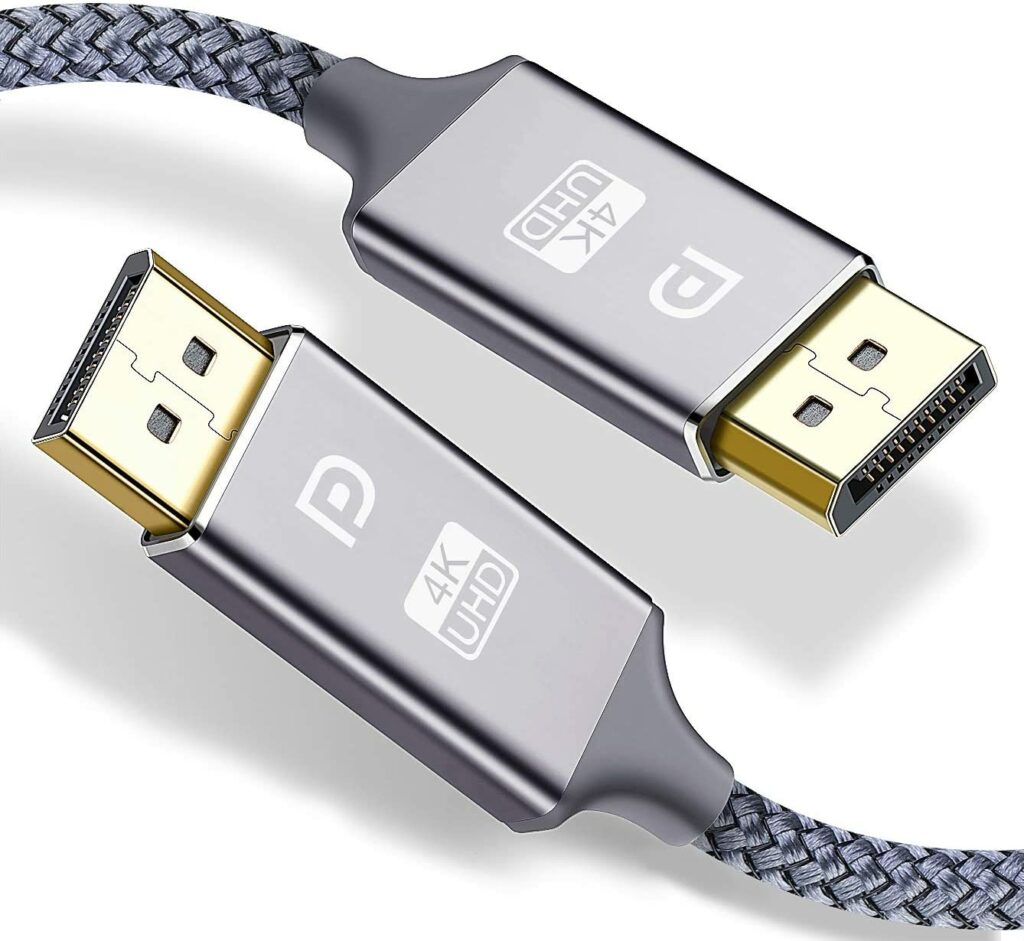
Capshi is a bit interesting as it is not only a newer company but also started as a smartphone accessory manufacturer before transitioning to audio and visual cables. Thankfully, this transition did not slow the company down as the Capshi DP to DP DisplayPort Cable is one of the best long term solutions we encountered.
It is worth noting that this DisplayPort cable is not actually more durable than other entries and suffers from the same durability issues many others do. However, the Capshi DP to DP DisplayPort Cable is one of the few options we reviewed with a lifetime warranty and responsive customer service.
Beyond that, this DisplayPort cable performs similarly to most that we encountered with durable wire made out of 28 AWG tinned copper to prevent corrosion. Though, the Capshi DP to DP DisplayPort Cable is another model that does not come with locking connectors, so be careful with moving the connected hardware.
This issue is further exacerbated by the fact that while sheathed in braided nylon, this DisplayPort cable only has a 3000 bend lifespan. On the other hand, this allows the Capshi DP to DP DisplayPort Cable to be more flexible than most other braided nylon sheaths, perfect for confined spaces.
Another bright spot is that this DisplayPort cable comes with 24k gold-plated connectors, integrated molding, and an aluminum alloy shell.
4. Benfei Display Port to HDMI
Most Accurate DisplayPort to HDMI Cable
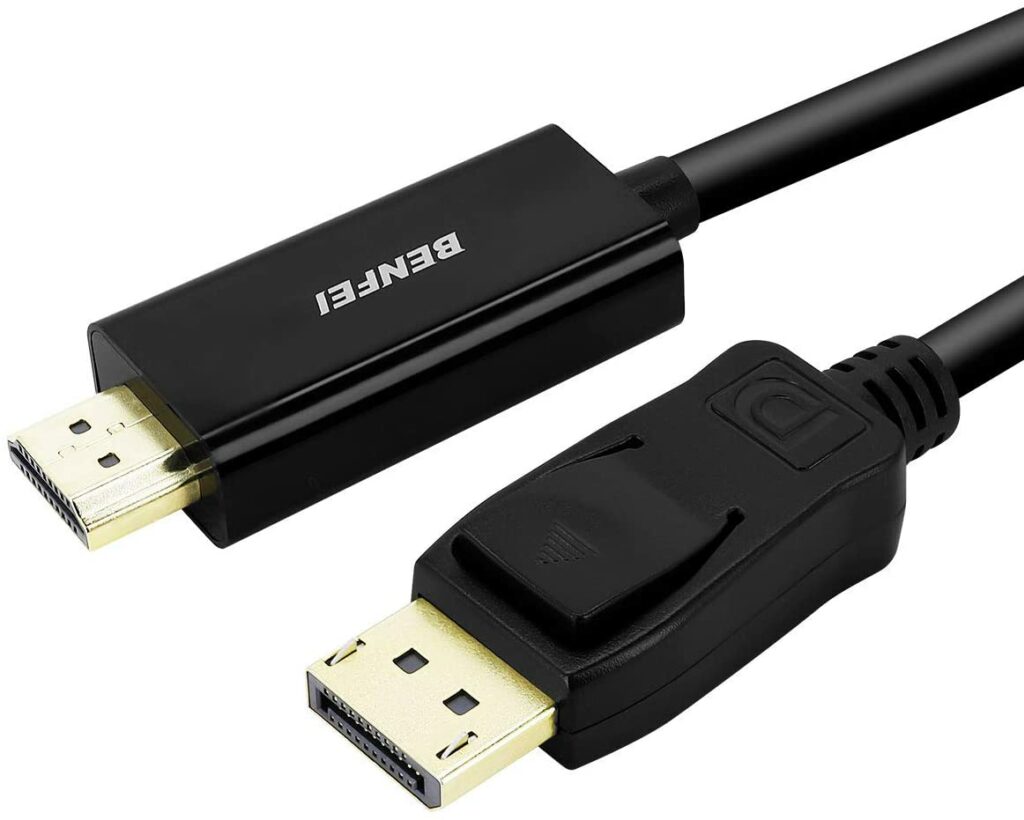
As has become the trend on our list, Benfei is a recent company focusing primarily on ethernet cables, but they extend it a bit beyond simply audio and visual purposes. Still, the Benfei DP to HDMI DisplayPort Cable brings something a little bit different to our list and does so with extreme clarity.
While most of the DisplayPort cables we reviewed are DP to DP, this entry allows you to connect a DisplayPort source to an HDMI display. While HDMI displays are far more common than 4K displays, it is worth noting that the Benfei DP to HDMI DisplayPort Cable is unidirectional and will not connect an HDMI source to a DisplayPort display.
Still, this DisplayPort cable performs better than most at its task as the 1.4 ver HDMI port allows the cable to transfer signals at all but the highest resolutions and refresh rates. As if that were not enough, the Benfei DP to HDMI Displayport Cable also boasts an advanced IC chip to make decoding the DP signal more accurate without loss.
Though, this DisplayPort cable is not anywhere near as durable as the DP to DP cables on our list due in part because it does not use braided nylon for its sheath. On the other hand, the Benfei DP to HDMI DisplayPort Cable employs thick PVC which affords it significantly more thermal insulation than most.
As a cherry on top, you do not have to worry about connection stability with this DisplayPort cable as its DisplayPort connector locks.
5. Cable Matters DisplayPort to DisplayPort Cable 4K Resolution Ready
Best Locking DisplayPort Cable
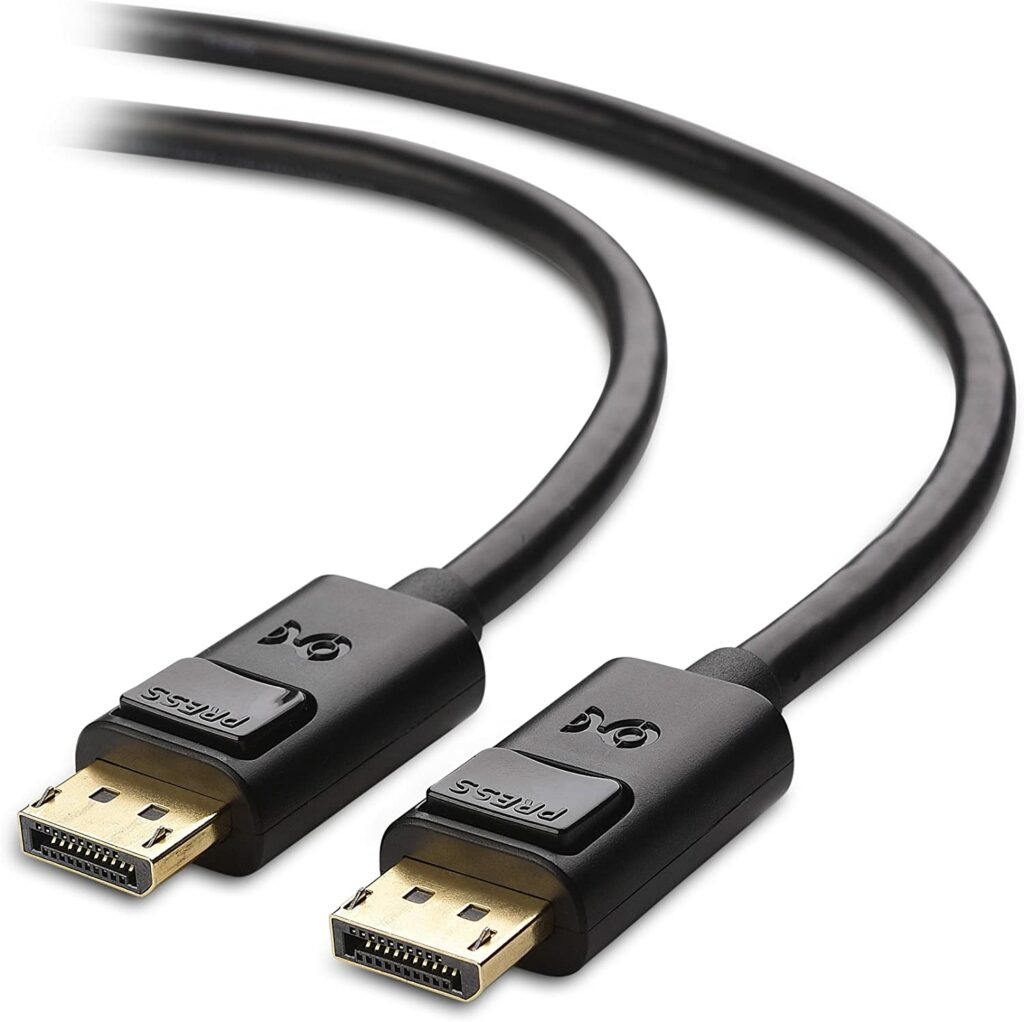
Cable Matters, as the company name implies, specializes in cables, though their selection tends to be broader than most of the competition we reviewed. On top of that, this company has the most experience on our list at 10 years, but the Cable Matters 102005 DisplayPort Cable sits in an odd spot.
While this DisplayPort cable offers many of the same specs as other models, it lacks the nylon braided sheath, opting instead for thick PVC. This makes the Cable Matters 102005 DisplayPort Cable a touch less durable in some ways, though it significantly increases the thermal insulation for confined spaces.
Even better, this DisplayPort cable does not suffer from the common reliability and electronics durability issues commonly found with other less-established brands. While the Cable Matters 102005 DisplayPort Cable is not VESA-certified, it is VESA compliant and merely awaits the appropriate testing at each length to receive its certification.
It is worth noting that this is one of the few DisplayPort cables we reviewed that uses bar copper wire instead of tinned copper, but it should not matter that much so long as the wire is not exposed. On a positive note, the Cable Matters 102005 DisplayPort Cable is the only entry on our list with locking connectors for mobile displays or VR.
It also does not hurt that this DisplayPort cable comes with three layers of shielding– though no magnesium for low frequencies.
6. Silkland Braided Display Port Cable (4K@60Hz, 2K@165Hz, 2K@144Hz)
Best Shielded DisplayPort Cable
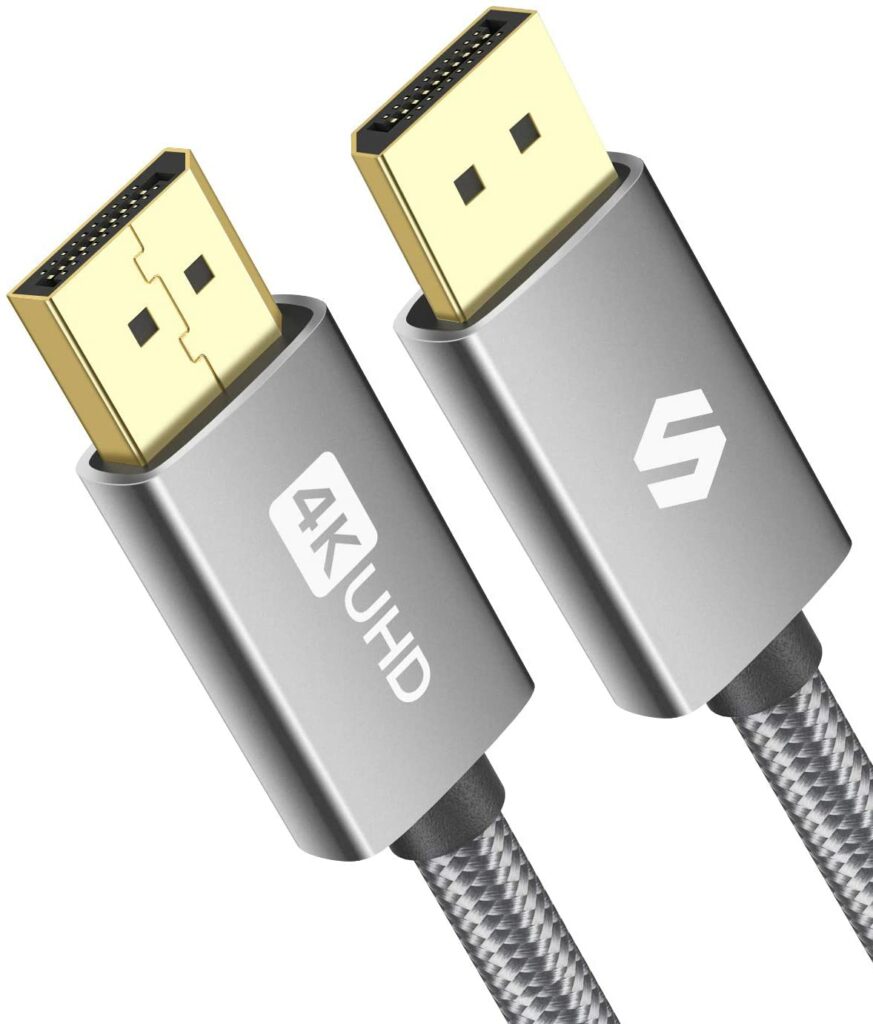
While a few of the companies on our list have much experience, Silkland is one of the newest with less than a year of experience but a specialization in cables. Thankfully, the Silkland DP to DP DisplayPort Cable follows other popular industry trends to provide a solid option with most of the features you expect to see.
For starters, this DisplayPort cable offers excellent shielding with a layer of aluminum foil surrounded by an aluminum-magnesium wire mesh to protect against low frequencies. Even better, the Silkland DP to DP Displayport Cable uses 28 AWG tinned copper wire for increased durability.
In terms of durability, this DisplayPort cable also employs a braided nylon sheath that ties our list as the second strongest with a 15000 bend lifespan, allowing it to also remain flexible. Unfortunately, the Silkland DP to DP Displayport Cable suffers from some of the same electronic durability issues that other newcomers do.
It is also worth noting that this DisplayPort cable follows the trend of non-locking connectors, making it a poor choice for VR or even some projector setups. Still, the overall build of the Silkland DP to DP Displayport Cable remains solid with 24k gold-plated connectors, an aluminum alloy housing, and integrated molding.
Thankfully, if anything does happen to this DisplayPort cable, you are protected by a lifetime warranty– though customer service is not always the most responsive.
7. Rankie DisplayPort (DP) to HDMI Cable, 4K Resolution Ready
Best DisplayPort to HDMI Cable
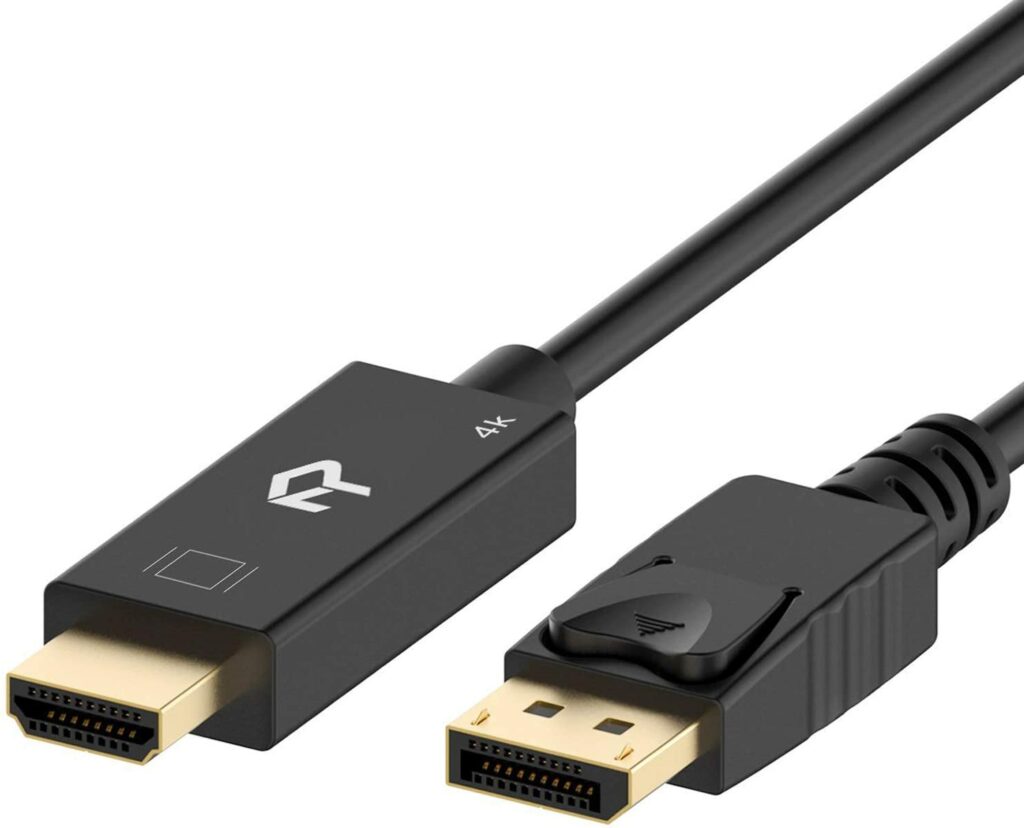
Rankie ends our list with another relatively inexperienced company specializing in cables but takes another approach and knocks it out of the park. The Rankie DP to HDMI Displayport Cable is the second such option on our list and offers a bit more in terms of raw specs compared to the competition.
Keep in mind that like other DP to HDMI DisplayPort cables, this entry is unidirectional and will not connect an HDMI source to a DP display. The main benefit that this DisplayPort cable offers over most is the ability to send 2K signals, though they are not always the most reliable depending on your hardware.
Still, you do not have to worry about loose connections with the Rankie DP to HDMI Displayport Cable thanks to its locking DisplayPort connector. Speaking of which, this DisplayPort cable uses 24k gold-plated connectors as well as tinned copper wire to ensure a consistent and durable connection.
Unlike some other DP to HDMI DisplayPort cables, this model also comes with multiple layers of shielding including aluminum foil and an aluminum wire mesh to reduce signal interference. Sadly, the Rankie DP to HDMI Displayport Cable does not employ the durable and flexible braided nylon sheath.
However, this DisplayPort cable uses a thick enough PVC sheath that you do not have to worry about thermal insulation in confined spaces.
How to Choose a DisplayPort Cable
Types
- DP to HDMI – HDMI is the most widely-adopted type of connection on the market which means that the transition to DisplayPorts will ultimately be a gradual one. Keep in mind that even most people who might have a 4K display or television likely do not experience their content in 4K unless it was made specifically in that format. Given that HDMI is an older form of technology, you might suspect that it is less expensive, but its ubiquity keeps its price competitive with DisplayPorts. One thing to consider with DP to HDMI cables is directionality as many cables of this type do not operate both directions.
- DP to DP – A DP to DP cable is a DisplayPort to DisplayPort cable where both ends feature a male DisplayPort connector. This is generally what people think of when they think of a DisplayPort connector, but because most consumers have various types and versions of hardware, it is not the only type. While you might expect the newer hardware to be more expensive, this is not necessarily the case as the build quality tends to weigh heavier. That said, if you have a DisplayPort source and a DisplayPort display, this is the kind of cable you should choose.
Versions
- DP – As display resolution continues to develop, DisplayPort becomes the necessary type of connection to transfer the larger amount of visual signals. In terms of raw performance, DisplayPort is a significant upgrade over HDMI and is required to run both 4K resolution and 3D graphics found in virtual reality. Keep in mind, the difference between HDMI versions is not always that significant, but the difference in DisplayPort versions can be far more pronounced. Though DisplayPort comes in version 2.0, version 1.2 offers most of the visual enhancements outside compatibility with 8K displays.
- HDMI – Given that HDMI has been around for 17 years, it only makes sense that this format boasts more versions than DisplayPort. While this might seem like a good thing, it also means that you may need to consider the hardware’s port version you connect to when choosing a cable. Thankfully, most modern HDMI ports come with the most recent and advanced version since the industry is slowly transitioning to DisplayPorts with the adoption of 4K. The newest version is 2.1 whose primary benefit is an 18.8% increase in encoding efficiency, though it is otherwise almost identical to the 2.0 versions.
Wires
There are a couple of different things to consider when judging the wire quality of a DisplayPort cable, though some of the specs can be a bit misleading. For example, with analog signals, the thickness also known as the gauge of the wire had a major impact on the resistance of the wire which influenced interference and signal distortion.
Thankfully, digital signals do not usually suffer from this issue unless the signal degrades well beyond most everyday instances. This is because the processor decoding the digital signal can read a binary 1 or 0 much easier than it can disentangle various frequencies from an analog signal.
That said, the quality of the digital signal and ability of a processor to decode the signal heavily depends on the gauge of the wire depending on the length of the cable. Thankfully, cables for consumer purposes rarely run the hundred or so feet of length before digital signals degrade to the point that interference becomes an issue.
Beyond the gauge of the wire, another thing to consider is the material of the wire, though most consumer-grade cables use copper wire due to its relatively low cost and high conductivity. Taking things a step further, some manufacturers coat their wires in tin to provide additional protection from corrosion though the benefits are minimal for wire protected by a sheath.
Shielding
While this may sound like a form of integral protection, and it does offer that quality to an extent, shielding for cables refers more to protection against electrical interference. Essentially, anything connected to a DisplayPort cable connects to a high-end piece of hardware that produces a strong magnetic field.
Depending on the hardware in question, the magnetic field might be strong enough to generate significant interference which can degrade the digital signal. That said, different cables use different materials, processes, and multiple layers of shielding to provide more protection from interference than others.
In terms of the materials used, the most common material is aluminum as it provides shielding against up to 85 dB of harmonic interference. That said, some companies combine aluminum with magnesium as aluminum does not protect from signal interference as well against low frequencies.
After the materials, the number of shielding layers is likely the most important, though few DisplayPort cables offer more than two layers with many only providing a single layer. Finally, DisplayPort cables tend to use at least an aluminum foil shield, though those with aluminum and magnesium may be formed into a mesh which also increases flexibility.
Sheath
This is not always the most important quality, but it may be more important depending on the space that houses the connected hardware. Basically, if you do not have a lot of space– and especially if you are in a confined space– a flexible DisplayPort cable makes it significantly easier to set up.
However, most cables use PVC for the sheath which, while great at insulating the area against thermal buildup, is extremely stiff without adding any additional durability. One way manufacturers get around this is by using nylon, another plastic, which is far more flexible than PVC.
To make sure that the nylon sheath offers more flexibility without losing out on durability, DisplayPort cables with this sheath braid the nylon. That said, you may need to balance the increased flexibility and durability of a braided nylon sheath with the lost thermal insulation by not using PVC.
Stability
Depending on the type of DisplayPort cable you need and its intended use, this quality will be more or less important. Basically, the DisplayPort connector is known for being fairly loose and unstable which is generally not much of an issue if you only intend to plug it into your devices and leave the entire setup stationary.
However, if you need to move or adjust the devices on the fly or the devices are inherently mobile, the lack of stability of a DisplayPort connection becomes far more troublesome. Generally, this instability is most commonly an issue for VR headsets or with projector monitors where you need to align the image thrown.
Thankfully, DisplayPort to HDMI cables only have to worry about this issue with the DisplayPort connector as HDMI connectors are inherently more stable– as anyone trying to unplug an HDMI cable can attest. That said, there are HDMI cables available that come with a locking mechanism to offer even more stability.
Conversely, DisplayPort cables tend to require a locking mechanism to ensure that you can adjust the hardware without having to worry about the DisplayPort connection coming undone. Unfortunately, many consumers do not like having to remember to unlock the cable, so manufacturers are starting to make DisplayPort connectors without locks.
Insulation
This is generally not one of the more important factors to consider when choosing a cable, but it can weigh more heavily depending on your situation. Specifically, if you live in a warm region and plan on connecting devices in an otherwise confined or compact area, it is always a good idea to have superior insulation.
It is worth noting that the insulation of DisplayPort cables does not benefit the cable itself as much as it affords everything around it a bit more thermal breathing room. That said, the only instance where this might be important is for computers where managing internal component temperature is vital for long term and consistent use.
In terms of the actual insulation, DisplayPort cables almost always use PVC as it offers excellent thermal insulation, is reasonably flexible, protected against rot and corrosion, and balances cost with durability. In this regard, the main thing to consider is whether you want one or two layers of insulation, though dual insulation requires a PVC sheath.
Conclusion
In the end, the best DisplayPort cable will depend on what kind of devices you connect more than most factors given that the market tends to follow a fairly common standard. However, there are a couple of minor differences between the brands that can clue you into which might be the best option for you.
For starters, if you do not have a 4K display, you likely do not need to worry about a DP to DP cable unless your HD display can run at an extremely high refresh rate. If this is the case, then the Rankie DP to HDMI Cable or Benfei DP to HDMI Cable are more than suitable with the Rankie having the edge in performance.
If you need a longer DisplayPort cable, the JSAUX DP to DP Cable is the only option we reviewed that comes in 3m without influencing other factors. For another niche situation, those who need a DisplayPort cable with more stability should look to the Cable Matters DP to DP Cable as its connectors lock into place.
If your DisplayPort cable will be around devices that produce strong magnetic fields, the Silkland DP to DP offers more layers of protective shielding than most. While many of the options on our list have some durability or reliability issues, the Capshi DP to DP DisplayPort cable at least offers a lifetime warranty with excellent customer service.
Finally, the iVanky DP to DP Cable covers all of the bases with a great build that blends flexibility and durability with solid specs suitable for high-end use.
TL;DR – The 7 Best DisplayPort Cables in 2020
- iVANKY 4K DisplayPort to DisplayPort Cable – Best All-Around DisplayPort Cable
- JSAUX Gold-Plated Braided Ultra High Speed DisplayPort Cord – Best 3M DisplayPort Cable
- Capshi DisplayPort Cable 4K DP Cable Nylon Braided – Best Long Term DisplayPort Cable
- Benfei Display Port to HDMI – Most Accurate DisplayPort to HDMI Cable
- Cable Matters DisplayPort to DisplayPort Cable 4K Resolution Ready – Best Locking DisplayPort Cable
- Silkland Braided Display Port Cable – Best Shielded DisplayPort Cable
- Rankie DisplayPort (DP) to HDMI Cable, 4K Resolution Ready – Best DisplayPort to HDMI Cable





